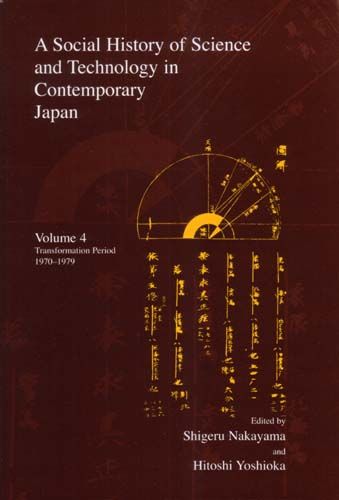Yoshioka, Hitoshi. 2006. “Future Plans for Nuclear Physics Research,” “The Rise of Nuclear Fusion Research,” “The Development and Utilization of Nuclear Reactors.” In A Social History of Science and Technology in Contemporary Japan: Volume 4: High Economic Growth Period, 1960-1969, edited by Shigeru Nakayama and Hitoshi Yoshioka, 189-273. Melbourne: Trans Pacific Press.

Volume 4 of A Social History of Science and Technology in Contemporary Japan contains three chapters of note to those interested in Japanese nuclear history, all of which were written by Hitoshi Yoshioka. Chapter 8, “Reorganization of the Administration and Regulation of Nuclear Development,” describes the establishment of the Nuclear Safety Commission (Genshiryoku Anzen Iinkai) in 1978 and the concomitant increase in the role of the Ministry of International Trade and Industry (MITI) in the development of nuclear technology. Chapter 9, “Nuclear Power Plant Location Disputes,” addresses the politics of determining where nuclear power plants would be built. It also details the ill-fated attempt to build a nuclear-powered commercial ship. Finally, Yoshioka describes the development of the technology and infrastructure to enrich uranium and reprocess spent fuel in Chapter 10, “The Development of Nuclear Fuel Cycle Technology.” These three chapters highlight different aspects of the social, political and technical history of the nuclear power industry in Japan. They explore how the development of reactors occurred in historically specific contexts of strenuous efforts and political struggle by a variety of local, official and commercial actors over a period of time during which outcomes were uncertain.
Chapter 8, “Reorganization of the Administration and Regulation of Nuclear Development,” describes the process by which MITI expanded its influence over the nuclear industry in the 1970s and 80s, eventually gaining control over a portion of the research and development of nuclear power that had been the sole reserve of the Science and Technology Agency (STA). Unlike the large and powerful U.S. Nuclear Regulatory Commission (NRC), the smaller Japanese Nuclear Safety Commission (NSC) could only review the actions of MITI and the STA, and was effectively sidelined as nothing more than a bureaucratic advisory board.
Chapter 9, “Nuclear Power Plant Location Disputes,” shows how one of the main barriers to the construction of power plants was convincing local fishing collectives to abandon their fishing rights to the waters near the plant. Since the Edo period, villages have enjoyed the right of communal access to fishing grounds adjacent to their land, and laws in the nineteenth and twentieth centuries confirmed these rights. Unless the locals ceded these rights, nuclear power plants could not gain access to the water they needed to operate. This chapter details the strategies that fishing cooperatives and other citizens used to slow or prevent the building of nuclear power plants in their regions, including a page or two on the resistance efforts in Fukushima.
Also in Chapter 9, Yoshioka highlights the asymmetry of protest power by presenting the case of an experimental nuclear-powered vessel, the Mutsu. In 1974, when the government tested the boat’s reactor without the approval of the local fishing cooperatives, the locals surrounded the ship with 300 fishing boats. The Mutsu sneaked out of port under the cover of a typhoon and promptly sprang a leak in its reactor coolant. It remained adrift for 45 days while fishermen blockaded its return to port.
Chapter 10, “The Development of Nuclear Fuel Cycle Technology,” describes how nuclear waste reprocessing technology preceded the development of fuel enrichment technology in Japan. Reprocessing technology was imported from abroad while enrichment was developed locally. In addition to technical and political challenges (such as Japan’s treaty obligations to the U.S.), Yoshioka attributes the delay of a decade between the development these two lines of technology to the Japanese government’s policy of prioritizing nuclear reactors over fuel technologies. Regardless of the timing, however, the ability to both enrich uranium and reprocess spent fuel allowed Japan eventually to achieve its goal of having an independent fuel cycle, in which virtually the entire life cycle of nuclear fuel could be handled domestically.
These three chapters are of particular interest to readers looking for historical contextualization of the development of reactors such as those at Fukushima, and the industry that supports them. Although, once established, the existence of such reactors may seem solid and non-negotiable, Yoshioka demonstrates that the path of their development was by no means natural or inevitable, and did not take place in a political vacuum.
– Craig Nelson
Further reading on Hitoshi Yoshioka’s histories of nuclear power in Japan:
- A Social History of Science and Technology in Contemporary Japan: Volume 2: Road to Self-Reliance, 1952-1959
- BOOK: A Social History of Nuclear Power: Its Development in Japan (1999)
- CHAPTER: Technology versus Commercial Feasibility: Nuclear Power and Electric Utilities (1999)
![[Teach311 + COVID-19] Collective](https://blogs.ntu.edu.sg/teach311/files/2020/04/Banner.jpg)
Pingback: FILM: Ashes to Honey (2010) | Teach 3.11